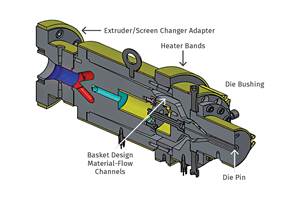Extrusion: Multi-Pass Tubing Tank Offers Higher Quality, Resin Savings
A new cooling and sizing tank for extruded tubing reportedly allows processors to reduce wall-thickness tolerances and cut material use dramatically while increasing productivity and reducing floorspace requirements.
A new cooling and sizing tank for extruded tubing reportedly allows processors to reduce wall-thickness tolerances and cut material use dramatically while increasing productivity and reducing floorspace requirements. Developed by Conair Extrusion, Cranberry Township, Pa. (conairgroup.com), the new MedLine MultiPass unit is especially suited for medical tubing.
The tank is so named because it eliminates the series of tanks that are typically used for cooling and sizing tubing. Instead, an oversized, driven roller at the end of the tank reverses the direction of the tube as it exits the vacuum chamber and guides it in a second pass through the cooling water. With new OD, ID, and wall-thickness control algorithms, new tension-control devices, and precision puller technology, this unit reduces tolerances to levels never seen before, according to Conair.
“Like any multi-pass tank, this new unit cuts floorspace requirements by sending the tubing along a back-and-forth path through the cooling water, but that’s where the similarity ends,” explains Bob Bessemer, medical downstream extrusion sales manager. Vacuum sizing is the biggest distinction between this and other models, he adds. “Vacuum sizing is inherently more controllable than air-pressure sizing, and we’ve demonstrated success in extruding flexible PVC, TPE, TPU, and PE commodity tubing,” Bessemer says. “For instance, by reducing tolerances from ±0.005 in. down to ±0.003 in., processors can save tens of thousands of pounds of material while increasing the amount of product produced. As the industry migrates from PVC to more expensive materials, saving even a few percent in material use becomes very important.”
The tank has several other advanced features, each of which contributes to improved process stability and tighter control of wall thickness, ovality, and cut-to-length tolerances, according to the supplier. For instance, the large-diameter roller that reverses the direction of the tube is designed to minimize the potential for tube distortion or flattening. And because it is driven by a closed-loop vector drive or digital servo, it acts as the primary puller in the line, minimizing the stretching that can occur when the primary puller is 100 ft or more downstream.
The tank also has precision glass bearings on non-driven rollers that further reduce drag and stretching as the tubing makes subsequent passes through the tank at line speeds approaching 800 ft/min. A load cell measures tension on the tubing and sends a signal to the secondary puller outside the tank to adjust speed to maintain a consistent and repeatable tension and prevent shrinkage issues. And two gauging units—an ultrasonic gauge upstream and a laser gauge downstream—are linked to the pullers to control wall thickness, concentricity, and ovality.
Because the tank uses vacuum sizing instead of air pressure in free extrusion, Bessemer also reports that is less affected by automated downstream functions like cutting to length and coil winding. “Where processors might have avoided using these techniques because of their impact on overall tube tolerances, they can now confidently institute these labor-saving techniques and cut costs further while increasing productivity,” he says.
Systems are also offered for non-medical products, like aquarium, small-gauge irrigation, and pneumatic tubing.
Related Content
Understanding Melting in Single-Screw Extruders
You can better visualize the melting process by “flipping” the observation point so the barrel appears to be turning clockwise around a stationary screw.
Read MoreSingle vs. Twin-Screw Extruders: Why Mixing is Different
There have been many attempts to provide twin-screw-like mixing in singles, but except at very limited outputs none have been adequate. The odds of future success are long due to the inherent differences in the equipment types.
Read MoreHow Screw Design Can Boost Output of Single-Screw Extruders
Optimizing screw design for a lower discharge temperature has been shown to significantly increase output rate.
Read MoreHow to Select the Right Tooling for Pipe Extrusion
In pipe extrusion, selecting or building a complementary set of tooling often poses challenges due to a range of qualitative factors. Here’s some guidance to help you out.
Read MoreRead Next
For PLASTICS' CEO Seaholm, NPE to Shine Light on Sustainability Successes
With advocacy, communication and sustainability as three main pillars, Seaholm leads a trade association to NPE that ‘is more active today than we have ever been.’
Read MorePeople 4.0 – How to Get Buy-In from Your Staff for Industry 4.0 Systems
Implementing a production monitoring system as the foundation of a ‘smart factory’ is about integrating people with new technology as much as it is about integrating machines and computers. Here are tips from a company that has gone through the process.
Read More




















